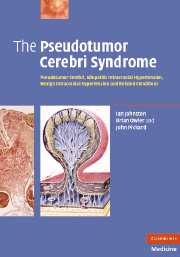 The Pseudotumor Cerebri Syndrome
The Pseudotumor Cerebri Syndrome Book contents
4 - Nosology, nomenclature, and classification
Published online by Cambridge University Press: 21 August 2009
Summary
Introduction
One of the fundamental questions regarding this syndrome, to which a rather bewildering variety of names has been applied, is whether there is, in fact, a single disease with a sufficiently distinct clinical picture but an as yet unidentified mechanism, or several separate conditions gathered together on practical or theoretical grounds. The practical grounds would be the uniformity of the clinical picture or the applicability of a uniform therapeutic approach whilst the theoretical grounds would be a variety of causative factors acting through a single common mechanism or a common pathology, for example, diffuse extracellular oedema, or an increase of CSF volume located in an ultimately identifiable part of the overall CSF compartment, or an increase in CBV, or some combination of these pathologies.
These questions were addressed in the previous chapter and from the findings and speculations considered there it is obvious that the situation remains quite unresolved. All that can be said with any confidence is that there is a clinically identifiable condition of raised intracranial pressure without focal or general neurological signs, at least in the great majority of cases, and which in some cases runs a short, benign and self-limiting course, but in others a prolonged course that is not self-limiting, and that carries considerable risk to visual function and possibly some risk to cognitive function. Basically, two approaches are taken to this condition or conditions at the present time.
- Type
- Chapter
- Information
- The Pseudotumor Cerebri SyndromePseudotumor Cerebri, Idiopathic Intracranial Hypertension, Benign Intracranial Hypertension and Related Conditions, pp. 60 - 81Publisher: Cambridge University PressPrint publication year: 2007


